Media | Articles
6 Oddball Concept Cars from the 1990s
We love talking about concept cars of every era, but the 1990s have a special place in our heart. It was a good decade for automotive diversity, especially for enthusiasts: SUVs were emerging as a hot new segment, true, but none of them purported to be a coupe or track star. Sport sedans thrived. So did hot hatches. The Miata debuted in 1989, kicking off the roadster craze. Chrysler was, for most of that decade, just Chrysler—not some confusing multinational conglomerate with a name that no one remembers.
Even the automotive ideas that didn’t make production had pizzazz—in a few cases, as you’ll see below, perhaps a little too much pizzazz. We’ve covered ’90s concepts before, but after a spin through the treasure trove that is Alden Jewell’s catalog of car brochures on Flickr, we decided it was time to focus on the concept cars from the U. S. of A., rather than the European contingent that dominated that last list.
Step back in time with us to an era when Buick was thinking of wild sedans, Pontiac was still cool, Mercury … existed, and Dodge was high off the Viper.
1999 Buick Cielo
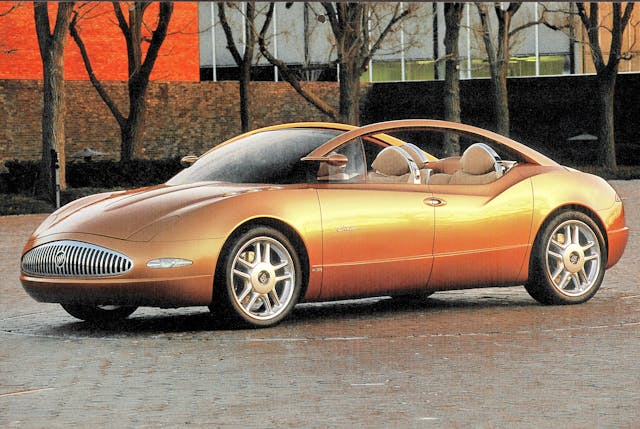
If you thought Buick’s newest concept car was unorthodox, prepare yourself: The Cielo is much, much more out-of-the-box. (Despite that throwback grille texture, which is very Y-Job.) A four-door convertible, with retractable headlights and voice-operated doors? You’d never know this thing was based on a highly modified Regal GS. The top, complete with its rear glass, stowed beneath a panel at the back thanks to a cable system hidden in the two arches that frame the “roof.” Power came from a supercharged 3.8-liter V-6 making 240 horsepower.
Judging by the much tamer concept of the same name that Buick showed off the following year—and marketed as a possible limited edition—the automaker thought the convertible four-door idea had legs. In Buick’s words, the Cielo “proves just how broad and flexible and contemporary the idea of a premium family car really is.” Little did Buick know that, 15 years later, the only premium family car the people would want was an SUV …
Marketplace
Buy and sell classics with confidence



1997 Mercury MC4
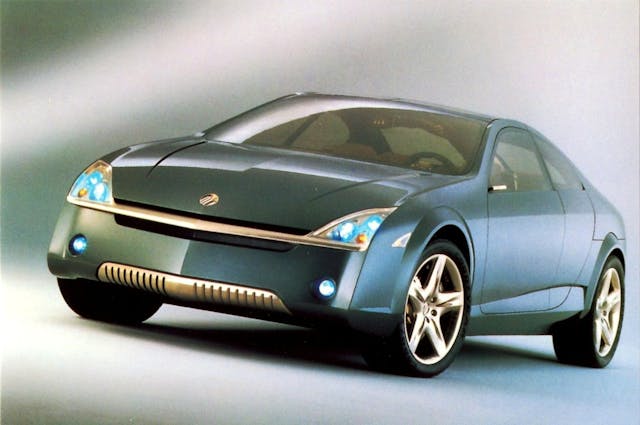
Motortrend got rather excited about the MC4 when it debuted in 1997: “The MC4 is for Mercury what the Viper Roadster was for Dodge nine years ago.” Yes, it was far more interesting to look at than the blob-like Mystique or the softly contoured Mountaineer … but no one knew that, 13 years later, Mercury would stop producing vehicles, its sales cannibalized by parent company Ford.
In 1997, however, Mercury’s star shone far brighter. The MC4 wore the edgy, minimalist look characteristic of Ford’s New Edge design language, initiated by the GT90 concept in 1990 and most familiar to folks on the 1999 Mustang. A trapezoidal grille and emphasized wheel arches are common to both that Mustang and the MC4, which actually started life as a V-8–powered ’96 Thunderbird. Unlike the T-Bird, the Mercury concept boasts four doors and a rear cargo area accessed by a pair of gullwing doors. It had style, space, and, of course, a healthy dose of tech that hadn’t quite been readied for production: video cameras instead of side- or rearview mirrors, nickel-chrome plate bedazzling the interior, and heated and cooled cupholders.
1997 Pontiac Rageous Concept
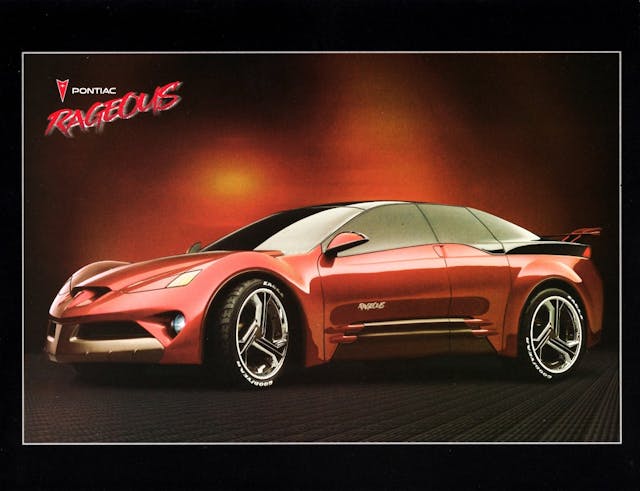
In 1997, Pontiac had four-door cars, and it had V-8–powered cars, but it didn’t have any V-8–powered, four-door cars. The Rageous, with its 350-cubic-inch small-block and vestigial set of rear doors, aimed to fix that. It could carry four people, but the trunk was accessed via a top-hinged hatch, making this more of a hatchback than a sedan. The Rageous had a six-speed manual transmission and a heavily vented, pointy schnoz that put that of the contemporary Firehawk to shame.

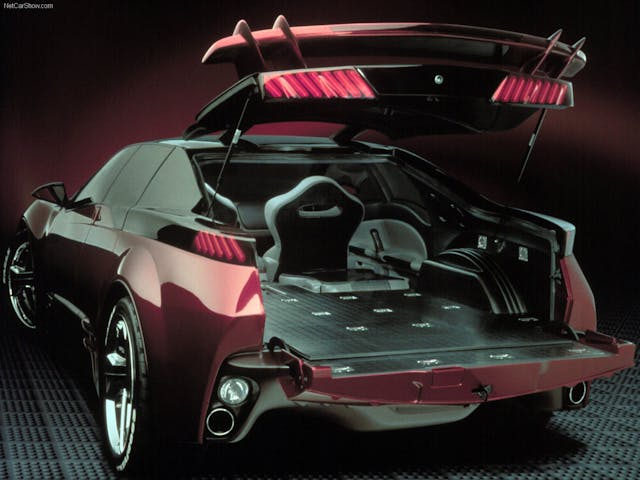
1994 Dodge Venom

If the Dodge Venom reminds you of a Neon, you’re on the right track: This 1994 concept was built on a version of the Neon’s platform. Unlike that compact, however, the Venom was rear-wheel drive. Compared to the sportiest Neon, the SRT-4, the Venom boasted an iron-block six-cylinder engine with 24, rather than 16, valves, and more power: 245 rather than 215 horses. The Venom looked like the perfect little brother to the Viper, which it honored with that side-scoop and squinty headlights atop a four-section grille. The concept even made the cover of Car and Driver‘s March 1994 issue, accompanied by the question: “Dodge’s pony car of the future?”
We wish such an affordable, spunky two-door had made production: Dodge wouldn’t have a direct competitor to the Mustang and the Camaro until the Challenger, which hit the streets 14 years later.
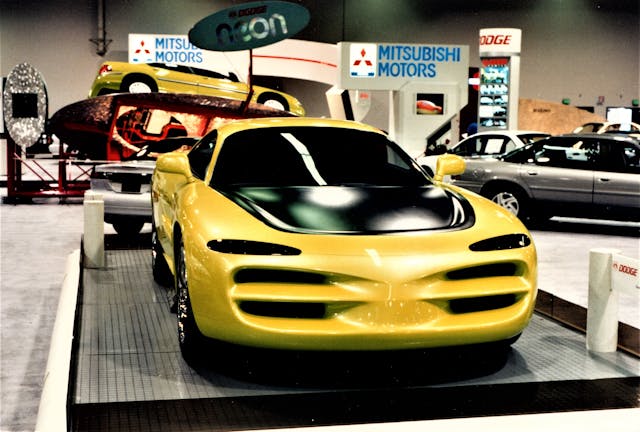
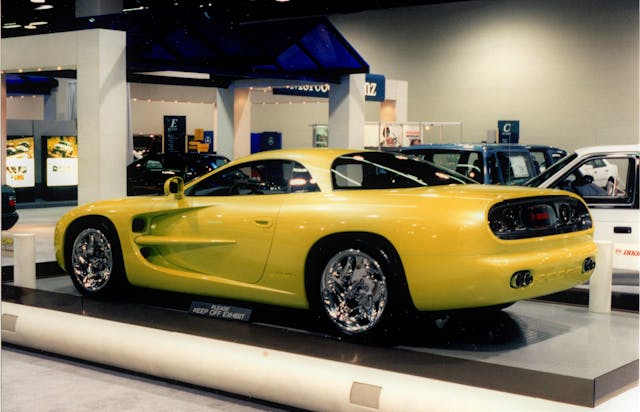
1995 Chevrolet El Camino SS Concept

It may remind GM fans of a Holden, but the El Camino SS Concept ute is a GM B-body at its core. GM’s Advanced Vehicle Development Center in North America built this ute out of a Caprice station wagon in just 16 weeks, grafting onto that people-hauler the nose of an Impala SS. Many of the steel body panels were made by hand. Power came from a 300-hp version of the LT1 V-8 found in the Corvette and the Impala SS (in different tunes) and was channeled to the rear wheels via a 4L60E Hydramatic transmission. Unfortunately, the platform that gave it birth spelled its doom: GM killed the age-old B-body at the end of 1996. RIP.
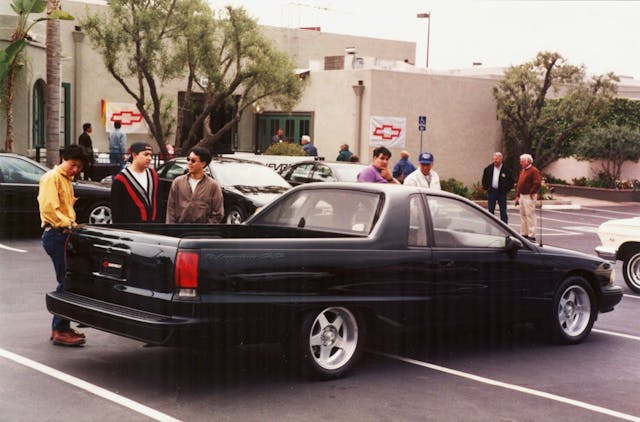
1994 Plymouth Expresso Concept

Would you believe us if we said this was a Plymouth? Maybe not, because the Expresso is more interesting than anything Plymouth made in the ’90s … until the Prowler arrived for the 1997 model year, at least. (That retro-mobile debuted in concept form the year before the urban runabout Expresso debuted.) The Expresso was built on the shortened frame of a Neon, to be sold under both the Dodge and Plymouth brands, and used the compact’s 2.0-liter four-cylinder to power its front wheels.
The four-door bubble would never reach production, but its name stuck around in the Plymouth lineup as a trim package on the Neon, the Voyager, and the Breeze. Be prepared to explain yourself if you mention this concept in front of a coffee snob: This weirdo’s name really is EX-presso, not Espresso. The proper pronunciation would be too … well, proper.
***
Check out the Hagerty Media homepage so you don’t miss a single story, or better yet, bookmark it. To get our best stories delivered right to your inbox, subscribe to our newsletters.


















This was the end of the car of the future era like show cars. Soon after most started to take the future production car and make it a show car era.
They missed the boat ElCa. Need to come back .
That’s why they never materialized into production, they were truly oddballs at its best
It’s hard to make a concept car out of a jelly bean.
The El Camino seems like it would have been the simplest to produce and would have a cult fanbase of those who liked the older ones. An SS package would have made it a modern-day collectible.
That El Camino design on the SS reminds me a bit of an open-back Flower Car in a funeral procession, honestly.
I like the Copperhead much better than that Venom, which is horrible.
Why why why did they kill Pontiac ? The concepts cars looks amazing even now
Part of the bankruptcy loan agreement in 2009. It expressly said to kill Pontiac and another brand of their choice. I wish I was making this up.
Pontiac was only a worn-out cliche by that time.
Correct, GM had to kill Pontiac and Saturn. They also had to sell off Hummer.
I’ll never purchase another GM product as a result. They took the money. They still haven’t paid it back. They should have parked a new car in each of our driveways for how much bail out they took.
And instead of the Rageous they made the Aztec?!!!
That was my exact thought sir, I’ve had some fun pontiacs through out the years but they were known to make some bad decisions such as the aztec and trying to replace the transam with a compact “gto” which might as well been a civic with a transam drive train.
The Outrageous Azkick.
I agree on the discontinued Pontiac branding. Loved the Pontiac styling. Buick should have been discontinued.
Buick’s were and are selling extraordinarily well in China and as such were extremely popular, even though they haven’t been very popular in America for a while.
It was part of Obama’s deal with the government bailout of GM. The killing of the 350 v8 in cars, trucks and as a crate motor supplied to different international medium duty cab over truck manufacturers.
“Out of the box” and “outside the box” don’t mean the same thing at all.
bump
Plymouth Pronto Spyder, Chrysler Atlantic
And the Chrysler Imperial.
Chrysler ME412…albeit 2000’s, not 90’s
VENOM! RAGEOUS!
What’s up with the pseudo testosterone man-boy names?
To attract attention, like Stingray, Boss 302, Demon, Raptor and Lightning to name a few.
They just don’t sell when named “Little Flower”.
But Datsun was able to pull off “Fairlady” (sort of)
Yes, but only in Japan. Had to do with the musical “My Fair Lady” and one exec’s obsession. I much preferred my 1977 280 Z, truly a poor man’s Porche.
You missed the best one of all, the 1999 GTO concept car.
It was a much more aggressive looking car than what they eventually gave us…could’ve made a perfect Pontiac example for Zeta Platform if only Pontiac had lasted that long.
Mercury, Pontiac, Plymouth… all gone now.
Didn’t even read the write up on the yellow car. The something something from what’s it’s name.
I was ready to write a check for the proposed, new, G8 Pontiac based “El Camino like” pickup truck. In fact, Pontiac ran a contest to name it and I submitted the name “G8TOR” a play on the G8 designation, it’s having a tailgate, and, in a stretch, gator as in alligator as the car would have been produced in Australia by Holden. I know, I know, they’re crocodiles in Australia but give me a break.
I bought my first new car when I was nineteen and it was a metallic red over black 1973 El Camino SS with a bench seat. I could have had a 454 with a four speed but opted for a 350 automatic because of insurance concerns. Turns out our family insurance agent said it wouldn’t have mattered anyway. I only had this car/truck for none months as it was a stopgap as I waited for insurance clearance on the brand new 1975 Corvette I bought because my Father wouldn’t let me buy used and get someone else’s headaches. As it was, timing is everything and the 1975 Corvette was the worst Corvette ever. I should’ve kept the El Camino.
Pontiac was my favorite GM division and I was ready to buy their new “G8TOR” with the 6.2 liter and a four speed. I was ready, but they weren’t, as they shut the division down along with Oldsmobile in a cost saving measure. As I already said, “timing is everything.”
In the late ’80’s, Ford had a least for a short moment, thought of putting the S.H.O. motor into a Taurus wagon along with all the chassis upgrades. Now that would have been sweet! My understanding was that a suitable automatic transmission was not easily sourced at the time, making the fledgling idea even more fleeting. I would have purchased one for sure if they had.
I had two SHO Tauruses and would have had a third if they’d built the wagon version (I bought an Audi S4 Avant instead). But what I was hoping to see here was the SHOstar concept. 1995 I believe. They put the Yamaha in a Windstar minivan, embellished a bit with headers, high-flow exhaust, and yes, maintained the 5-speed manual. What a sleeper! I confirmed with a Ford staffer it still existed in 2005 when he brought the 2005 GT to a show in Ann Arbor.
Mercury could have gained street cred by going with “MC5”. At least in Detroit. “Kick Out The Jams…”
;.)
I agree with Cory David, I was looking forward to the arrival of the G8 based ‘Ute” also. I still think about getting a G8, I looked at a few in the last couple of months, but they are 15 year old cars now, with the mileage on them to show their age, and parts availability is enough to scare me off to use one as a daily driver. I have enough toys already. It is what it is.
That little Dodge would have been great!